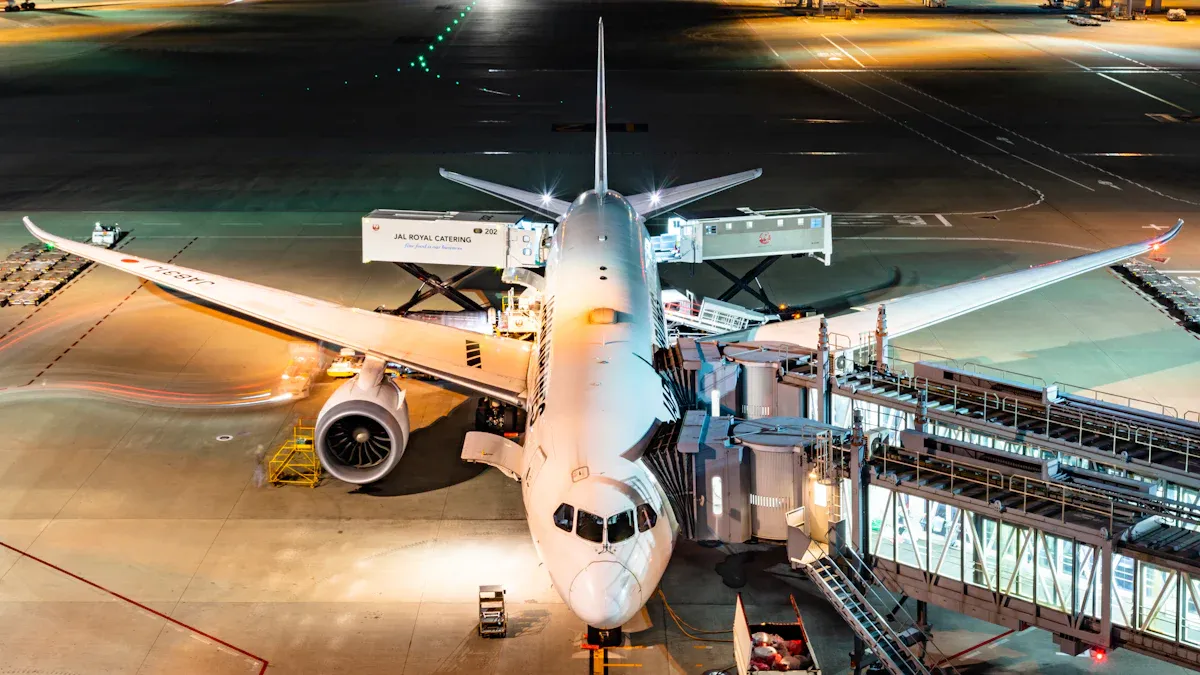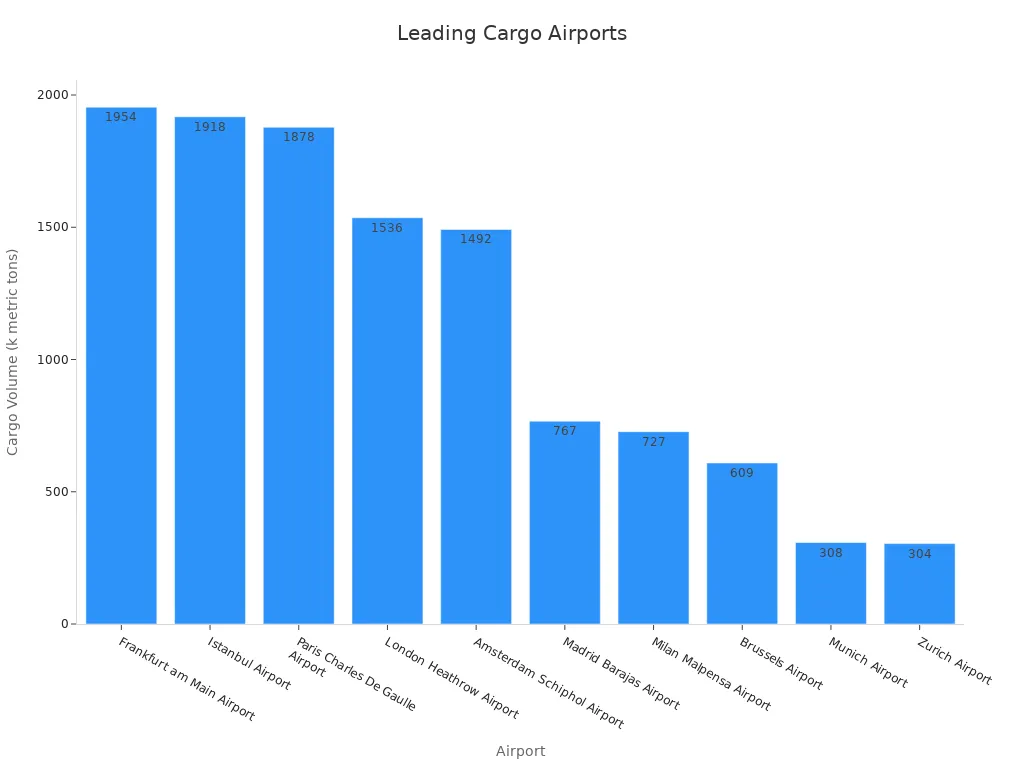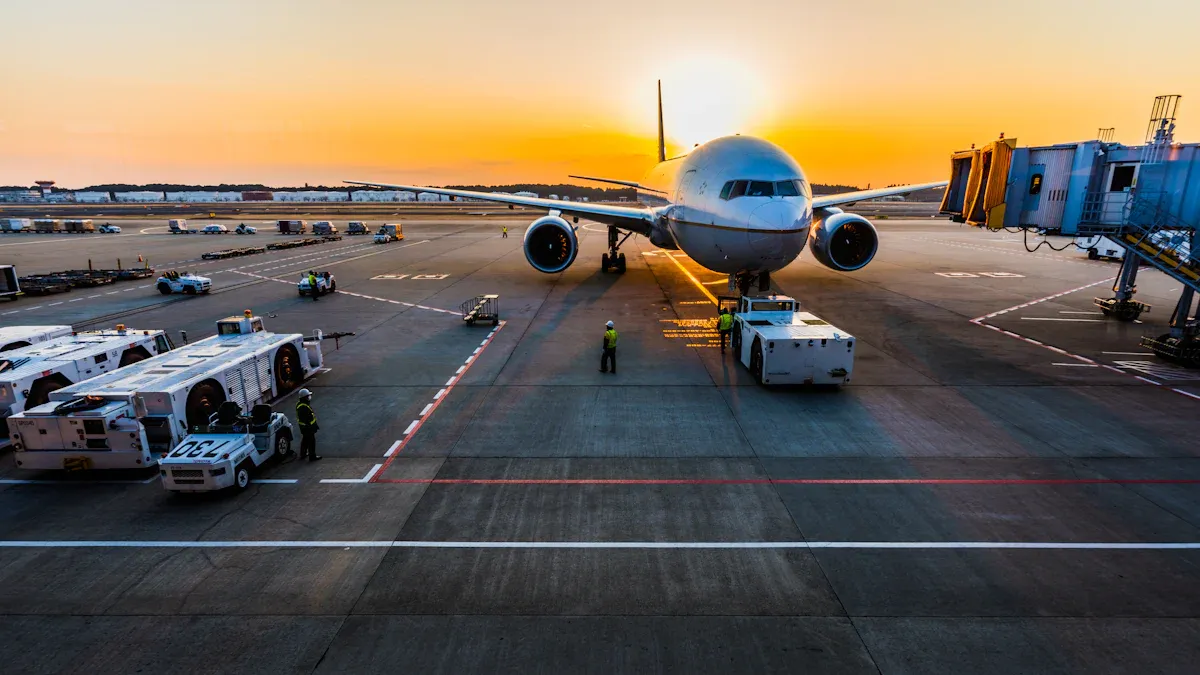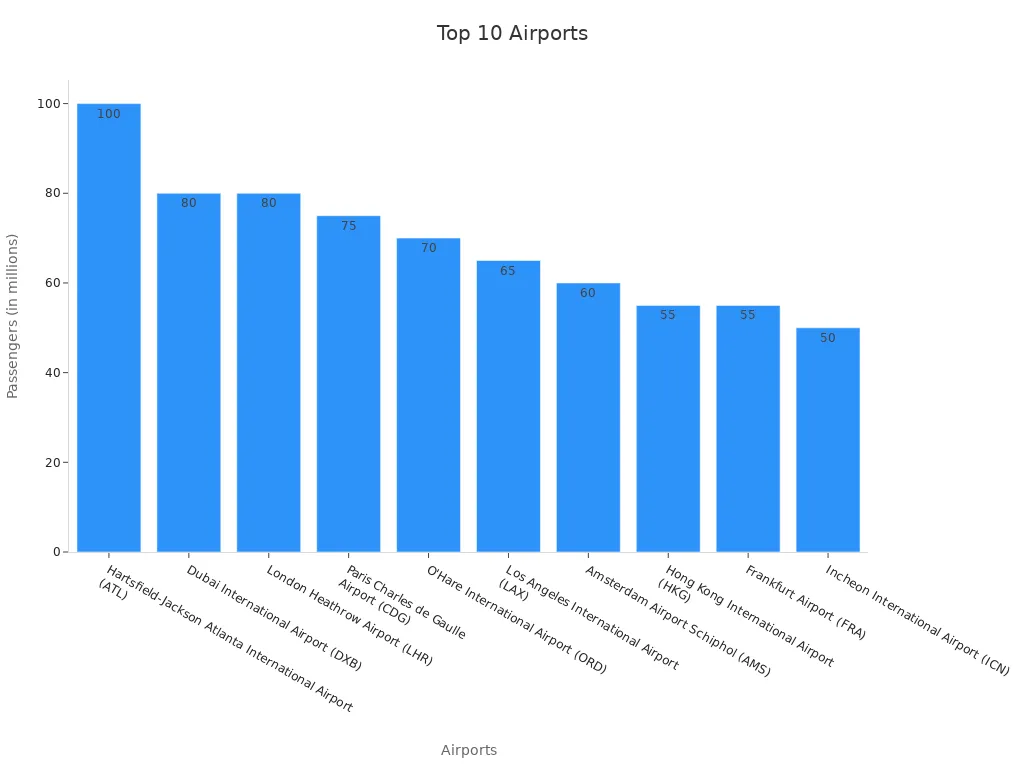The Busiest Airport in the World Defy Global Uncertainly and Hold Top Rankings

The busiest airports continue to thrive as indispensable hubs for global trade and connectivity despite ongoing challenges. Their resilience is evident in the Airports Council International's 2024 projections:
Global passenger traffic is expected to reach nearly 9.5 billion, marking a 9% increase from 2023.
The top 10 airports collectively handle 855 million passengers, representing 9% of global traffic.
Additionally, air cargo volumes are projected to surpass 124 million metric tonnes in 2024, driven by e-commerce demand and improved logistics efficiency. These airports remain critical arteries for economic activity worldwide.
Key Takeaways
By 2024, almost 9.5 billion people will travel by air. This is a 9% rise from 2023, showing how strong the airline industry is.
Hartsfield-Jackson Atlanta International Airport is still the busiest. It serves about 100 million travelers because of its great location and many flight connections.
Online shopping has increased air cargo traffic, making up 20-25% of all shipments. Airports need to adjust to handle this growing need for faster deliveries.
Airports must invest in new technology and buildings to work better and make travel easier. Tools like face scanners and automatic systems help speed things up.
Working with airlines and delivery partners, like JUSDA, helps airports solve problems and stay at the top worldwide.
Global Rankings of the Busiest Airports

Top Airports by Passenger Traffic
Passenger traffic remains a key metric for determining the busiest airports globally. In 2024, Hartsfield-Jackson Atlanta International Airport retained its position as the leader in passenger traffic, followed by Dubai International Airport and Dallas Fort Worth International Airport. These airports collectively handled millions of passengers, reflecting their critical role in global connectivity.
Hartsfield-Jackson Atlanta International Airport: Known for its strategic location and extensive domestic network, it continues to dominate the rankings.
Dubai International Airport: Its position as a major transit hub for international travelers solidifies its place in the top three.
Dallas Fort Worth International Airport: A key hub for North American travel, it benefits from strong domestic and international demand.
The Airports Council International (ACI) projects global passenger traffic to reach 9.9 billion in 2025, a 4.8% year-over-year growth. This growth underscores the resilience of the aviation industry despite economic uncertainties.
Leading Airports in Cargo Volume
Cargo traffic plays a pivotal role in the rankings of the busiest airports. Hong Kong International Airport leads in cargo volume, followed by Shanghai Pudong International Airport and Memphis International Airport. These airports serve as vital nodes for global trade, driven by the rise of e-commerce and efficient logistics networks.
Airport | Cargo Volume (in thousand metric tons) |
|---|---|
Hong Kong International Airport | 4,500 |
Shanghai Pudong International Airport | 3,800 |
Memphis International Airport | 3,500 |
The top 10 airports accounted for nearly 26% of global cargo volumes in 2024, with total air cargo volumes exceeding 124 million metric tonnes. This represents an 8.4% year-over-year increase, highlighting the growing demand for air freight services.

Airports with the Most Aircraft Movements
Aircraft movements, encompassing takeoffs and landings, reflect the operational efficiency of airports. Hartsfield-Jackson Atlanta International Airport once again leads in this category, followed by Chicago O’Hare International Airport and Dallas Fort Worth International Airport.
Hartsfield-Jackson Atlanta International Airport: Its extensive domestic and international operations contribute to its high aircraft movement numbers.
Chicago O’Hare International Airport: A major hub for connecting flights, it ranks second in aircraft movements.
Dallas Fort Worth International Airport: Its strategic location and airline partnerships ensure a steady flow of takeoffs and landings.
In 2024, global aircraft movements reached approximately 100 million, marking a 4.3% increase from 2023. This growth reflects the aviation industry's recovery and the increasing demand for air travel and cargo services.
Passenger Traffic: The Core of the Busiest Airports

Airports with the Highest Passenger Numbers
Passenger traffic remains a defining metric for identifying the busiest airports globally. In 2024, Hartsfield-Jackson Atlanta International Airport (ATL) led the rankings with approximately 100 million passengers. Dubai International Airport (DXB) and London Heathrow Airport (LHR) followed closely, each handling around 80 million passengers. These airports serve as critical hubs for both domestic and international travel, reflecting their strategic importance in the global aviation network.
Rank | Airport | Passengers (Millions) | Location |
|---|---|---|---|
1 | Hartsfield-Jackson Atlanta International Airport (ATL) | ~100 | Atlanta, Georgia |
2 | Dubai International Airport (DXB) | ~80 | Dubai, United Arab Emirates |
3 | London Heathrow Airport (LHR) | ~80 | London, England |
4 | Paris Charles de Gaulle Airport (CDG) | ~75 | Paris, France |
5 | O'Hare International Airport (ORD) | ~70 | Chicago, Illinois |
6 | Los Angeles International Airport (LAX) | ~65 | Los Angeles, California |
7 | Amsterdam Airport Schiphol (AMS) | ~60 | Amsterdam, Netherlands |
8 | Hong Kong International Airport (HKG) | ~55 | Hong Kong |
9 | Frankfurt Airport (FRA) | ~55 | Frankfurt, Germany |
10 | Incheon International Airport (ICN) | ~50 | Seoul, South Korea |

These airports have consistently ranked among the top due to their extensive connectivity, operational efficiency, and ability to adapt to evolving passenger needs.
Factors Driving Passenger Growth
Several factors contribute to the steady growth in passenger traffic at major airports. The International Civil Aviation Organization (ICAO) projects a significant increase in global passenger traffic by 2035, driven by economic growth and technological advancements. Key drivers include:
Increased disposable income, enabling more people to afford air travel.
The rise of low-cost airlines, making air travel accessible to a broader demographic.
A growing emphasis on sustainability, security, and personalized services, which enhances the overall passenger experience.
The expansion of the smart airport market, projected to grow at a compound annual growth rate (CAGR) of 14.9% from 2025 to 2032.
Additionally, U.S. airlines reported a 119% increase in passengers from October 2020 to October 2021, highlighting the aviation industry's recovery from the pandemic. The global aviation analytics market, valued at USD 2.95 billion in 2021, is expected to grow at a CAGR of 12.0%, further supporting the rise in passenger traffic.
Notable Changes in Rankings
The rankings of the busiest airports have seen notable shifts over the past decade. Shanghai Pudong International Airport (PVG) made a remarkable leap from 21st to 10th place in 2024, driven by expanded visa policies and the resurgence of international flights. Similarly, Istanbul Airport (IST) and New Delhi International Airport (DEL) climbed the rankings due to airline expansions and enhanced global connectivity.
Year | Passenger Boardings | Rank Order | Percent Change from Previous Year |
|---|---|---|---|
2022 | Data not provided | Data not provided | Data not provided |
2023 | Data available | Data available | Data available |
These changes reflect the dynamic nature of the aviation industry, where geopolitical factors, economic conditions, and infrastructure investments play pivotal roles. Airports that adapt to these factors and invest in modernization continue to thrive, securing their positions among the busiest airports globally.
Cargo Traffic: A Key Driver for the Busiest Airports
Airports Leading in Cargo Volume
Cargo traffic remains a critical metric for evaluating the performance of the busiest airports. In 2022, Hong Kong International Airport led the rankings, handling 4.2 million metric tonnes of cargo. Memphis International Airport followed closely with 4.0 million metric tonnes, while Anchorage secured third place with 3.4 million metric tonnes. Louisville and Cincinnati also demonstrated notable growth, with Cincinnati experiencing a remarkable 16.8% increase in cargo volume.
Airport Name | Cargo Volume (Metric Tonnes) |
|---|---|
Hong Kong International Airport | 4.2m |
Memphis International Airport | 4.0m |
Anchorage | 3.4m |
Louisville | 3.0m (0.5% growth) |
Cincinnati | 1.7m (16.8% growth) |
Despite these achievements, global air cargo volumes declined by 6.7% year-over-year in 2022, reflecting the challenges faced by the industry.
The Impact of E-commerce on Cargo Traffic
E-commerce has significantly influenced cargo traffic at major airports. Its share of air cargo volumes increased from 10% in 2017 to 20% in 2022, with projections suggesting it could stabilize at 20-25% by 2027. This growth has been fueled by the rising demand for cross-border e-commerce, which generates approximately $100 billion in revenue annually. Ludwig Hausmann from McKinsey highlighted that e-commerce now accounts for nearly a third of total air cargo volumes, underscoring its economic impact.
Year | Air Cargo Demand Growth | E-commerce Share of Air Cargo |
|---|---|---|
2017 | N/A | 10% |
2022 | N/A | 20% |
2023 | 10 consecutive months of growth | N/A |
2024 | Expected to slow to single digits | N/A |
Challenges in Cargo Operations
Cargo operations at the busiest airports face several challenges. Runway incursion risks remain a significant concern, as highlighted by audits conducted at 45 major U.S. airports. These audits, expected to conclude in early 2025, aim to address safety and operational efficiency. Additionally, fluctuating demand, capacity constraints, and geopolitical tensions complicate cargo logistics. Airports must invest in advanced technologies and infrastructure to overcome these hurdles and maintain their critical role in global trade.
Aircraft Movements: Operational Efficiency at the Busiest Airports
Airports with the Most Takeoffs and Landings
The busiest airports globally excel in managing high volumes of takeoffs and landings, a critical measure of operational efficiency. Hartsfield-Jackson Atlanta International Airport leads in aircraft movements, handling over 700,000 takeoffs and landings annually. Chicago O’Hare International Airport and Dallas Fort Worth International Airport follow closely, reflecting their strategic importance in connecting domestic and international routes.
Efficient aircraft movement management ensures minimal delays and optimal resource utilization. Airports achieving high operational efficiency often invest in advanced systems and infrastructure to handle the growing demand for air travel and cargo services.
The Role of Technology in Managing Aircraft Movements
Technology plays a pivotal role in enhancing the efficiency of aircraft movements at major airports. Advanced systems streamline operations, reduce delays, and improve safety. Key technological metrics include:
Metric Type | Description |
|---|---|
Advanced Radar Systems | Enhance situational awareness and improve resource allocation by providing real-time data on aircraft movements. |
Performance-Based Navigation | Allows for more flexible and efficient flight paths, potentially reducing fuel consumption and improving on-time arrivals. |
Gate Management Software | Automates gate assignments and improves communication, leading to better operational efficiency and passenger experience. |
These innovations enable airports to handle increasing traffic volumes while maintaining high safety and service standards. As global air travel continues to grow, adopting these technologies will remain essential for operational success.
Trends in Aircraft Fleet Modernization
Modernizing aircraft fleets is a growing trend among airlines, driven by the need for cost efficiency and environmental sustainability. Airlines are replacing older models with fuel-efficient aircraft to meet regulatory requirements and reduce operational costs.
Trend/Aspect | Details |
|---|---|
Airlines are replacing older aircraft with newer, fuel-efficient models to reduce costs and meet regulations. | |
Electrification of Short-Haul Flights | Electric aircraft are in prototype phase, focusing on emissions-free travel for short distances. |
Aircraft Leasing Market Trends | Fleet modernization with NextGen aircraft is reducing carbon emissions, with a focus on SAF. |
Sustainable Aviation Fuel (SAF) production has also seen significant growth, reaching 300 million liters in 2022, up from 100 million liters in 2021. This shift toward sustainability aligns with the aviation industry's broader goals of reducing its environmental impact.
The busiest airports benefit from these advancements as modern fleets contribute to smoother operations, reduced delays, and enhanced passenger experiences.
Strategies for Resilience and Growth at the Busiest Airports
Investments in Infrastructure and Technology
The busiest airports are investing heavily in infrastructure and technology to enhance their resilience and operational efficiency. These investments address growing passenger volumes, cargo demands, and environmental concerns. Key technological advancements shaping the aviation industry include:
Aircraft Efficiency: Modern aircraft designs with improved aerodynamics and fuel-efficient engines reduce costs and carbon emissions.
Digitalization: Online booking systems, mobile check-ins, and electronic boarding passes streamline passenger journeys.
Biometrics and Security: Facial recognition and fingerprint scanning improve security while expediting passenger flow.
Air Traffic Management: Satellite-based navigation systems enhance airspace efficiency and reduce delays.
Sustainable Aviation: Biofuels and electric aircraft are being developed to minimize environmental impact.
These innovations ensure that airports remain competitive and capable of handling increasing demands while prioritizing sustainability.
Enhancing Passenger Experience
Passenger satisfaction is a critical focus for leading airports. Studies reveal that improving service quality and reducing waiting times significantly enhance customer loyalty. For example, self-service technologies like automated check-ins and baggage drops improve efficiency and convenience. The following table highlights key research areas on passenger experience:
Study Title | Focus Area |
|---|---|
How to Outperform Airport Quality of Service | Enhancing airport quality of service through qualitative and quantitative data analysis |
Achieving Sustainable Customer Loyalty in Airports | Relationship between waiting time satisfaction, self-service technologies, and customer loyalty |
Components of Airport Experience | Impact of various components on passenger satisfaction and behavioral intentions |
Effects of Service Quality Dimensions | Influence of service quality dimensions and passenger characteristics on overall satisfaction |
Measuring Airport Service Quality | Quantitative framework for measuring airport service quality through a multidimensional approach |
By adopting these insights, airports can create seamless and enjoyable experiences for travelers, fostering long-term loyalty.
Collaboration with Airlines, Governments, and Supply Chain Partners like JUSDA
Collaboration is essential for the busiest airports to maintain their rankings and adapt to global challenges. Partnerships with airlines ensure efficient scheduling and route optimization. Governments play a vital role in funding infrastructure projects and implementing supportive policies. Supply chain partners like JUSDA contribute by streamlining logistics and enhancing cargo operations.
JUSDA’s innovative supply chain solutions, such as its JusLink intelligent platform, integrate IoT, cloud computing, and big data to optimize operations. This technology enables real-time tracking, demand forecasting, and efficient customs management. By collaborating with JUSDA, airports can improve cargo handling efficiency and support global trade. Such partnerships strengthen the aviation ecosystem and ensure resilience in an ever-changing environment.
The busiest airports demonstrate remarkable resilience and adaptability in maintaining their top rankings. Their success stems from strategic investments in infrastructure, technology, and partnerships. Airports adopt robust, digitally enabled trend-monitoring systems and flexible response plans to navigate disruptions effectively. These measures ensure operational efficiency and sustained growth.
Looking ahead, global air travel will continue evolving with advancements in sustainability and digitalization. Airports must embrace system-level strategies and scenario planning to address future challenges. By fostering innovation and collaboration, they will remain vital hubs for global connectivity and economic progress.
FAQ
What defines an airport as one of the busiest in the world?
Airports are ranked based on metrics like passenger traffic, cargo volume, and aircraft movements. These factors reflect their operational scale, connectivity, and role in global trade and travel.
How does e-commerce impact air cargo traffic?
E-commerce drives significant growth in air cargo demand. It accounts for nearly 20-25% of total air cargo volumes, fueled by cross-border online shopping and faster delivery expectations.
Tip: Airports investing in advanced logistics systems can better handle the surge in e-commerce-related cargo.
Why is Hartsfield-Jackson Atlanta International Airport consistently ranked first?
Its strategic location, extensive domestic network, and efficient operations make it a leader in passenger traffic and aircraft movements. It serves as a major hub for connecting flights across the United States.
How do airports manage increasing passenger volumes?
Airports adopt technologies like biometrics, automated check-ins, and real-time data analytics. These innovations streamline operations, reduce waiting times, and enhance the overall passenger experience.
What role does JUSDA play in airport cargo operations?
JUSDA optimizes supply chain efficiency through its JusLink platform. It integrates IoT, cloud computing, and big data to improve cargo tracking, customs management, and demand forecasting, supporting airports in handling global trade demands.
Note: JUSDA’s solutions help airports adapt to the growing complexities of international logistics.
See Also
Discovering Leading Global Logistics Firms: A Comprehensive Overview
Five Leading Logistics Programs to Watch in 2024
Exploring The Best Supply Chain Conferences You Should Attend
Understanding The Trends Influencing Logistics Risk Management
